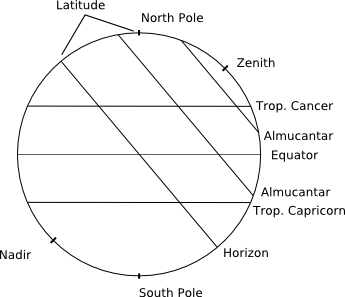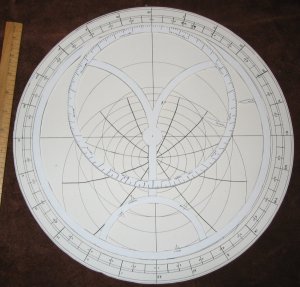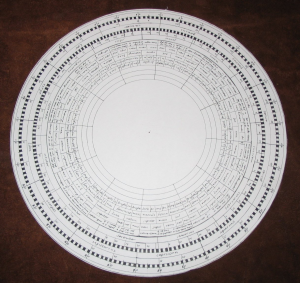
Holding the Heavens in my Hand: The Astrolabe as Astronomical Computer
Over the two years, I have been studying medieval and Renaissance astronomy and other sciences. My objective is to use period texts and period tools to increase my understanding of the early Renaissance way of relating to the world. My “viewpoint character” is Palmerin da Castello, a scholar at the University of Bologna in the late fifteenth century. Bologna at that time had a professor of astrology, and Palmerin is studying under him. Grendler (2002) describes the education at Renaissance universities in Italy, and even lists the texts that would have been taught. I have been reading those that are available in English translation, and working to understand both the science and the accompanying worldview.
Period texts are one way of relating to the world; period and reproduction items are another. The astrolabe was an integral tool for practicing the arts of the astrologer and astronomer, and provides a tangible representation of the celestial sphere. Unlike the simpler mariner's astrolabe, used for finding latitude while at sea, the planispheric astrolabe was used by people who knew where they are, but wanted to know the time. The major use of the astrolabe, and the use for which this one is intended, is as an analog computer for finding the position of bodies in the heavens relative to the local horizon. Given the time and date, a skilled astronomer could use the astrolabe to calculate most of the quantities needed for casting a horoscope, lacking only the positions of the planets, which would be provided by a set of tables for the appropriate year.
Although various modern calculation methods and astronomical tools are available to us today, I chose to construct my astrolabe using only tools and techniques available in the fifteenth century: a compass, a ruler and a protractor. (It can be done with only a compass and a ruler, but protractors were used in instrument workshops, and speed the work considerably). I used a pencil for layout, but final drawing was done with an inking compass and a dip pen. While using these tools led to increased calculation error in my inexperienced hands, it provided a level of understanding of the process of Renaissance science that I don't believe can be acquired any other way.
The mathematics behind the astrolabe (explained further below) were understood even by classical astronomers in the second century BCE. Ptolemy further refines the mathematics in the second century CE, and describes something that may or may not be a “proper” astrolabe. Astrolabes certainly existed by the seventh century, in essentially the same form they retained throughout the Middle Ages and Renaissance. Like so many other areas of learning, astronomy was lost in Europe, but retained in the Islamic world. There are Islamic astrolabes from the eleventh century, but no European examples until much later. Classical scientific texts were translated from Arabic into Latin, and many Arabic words remain in astronomical terminology (The title of Ptolemy's Almagest, almucantars on the astrolabe, and many star names are all derived from Arabic.) The oldest surviving European astrolabe dates from the fourteenth century, as does the oldest European treatise on the subject, attributed to Geoffrey Chaucer.
The Celestial Sphere
From the perspective of an observer on the surface of the Earth, and without a telescope, there is no difference whatsoever in the predictions of the geocentric and the heliocentric models of the solar system. For all practical purposes, and given the level of observational accuracy available, geocentric astronomy was completely suitable. During this period, there was no real difference between astronomy and astrology – the heavens were studied for what they can tell us about events in the earthly sphere. The conventions for describing the celestial sphere are essentially the same today as those developed by the classical astronomers over 2000 years ago.
The celestial sphere is marked off in circles (Figure 1). Some of these circles are referenced to the sphere itself, while others depend on the latitude of the observer. The fixed circles are oriented relative to the north pole, the point visible from the northern hemisphere about which the heavens turn. The equator is the circle that is halfway between the north and the south poles. The tropics of cancer and capricorn mark the most northerly and southerly points, respectively, that the sun reaches during the course of the year, about 23.5º north and south of the equator. (This value depends on the tilt of the earth's axis, and changes slowly over time. Rather than reproducing a medieval instrument exactly, I have updated all values for the modern era so that I can use the astrolabe without correcting for precession.) The ecliptic is the circle along which the sun travels, and also the planets, and follows the course of the zodiac.
Figure 1. The major circles subdividing the celestial sphere.

The latitude of a location is the angle between the horizon and the north pole. At the terrestrial north pole, the celestial north pole is directly overhead, so the latitude is 90º, while at the equator the celestial north pole is permanently on the horizon, and the latitude is 0º. The zenith is the point directly overhead, and the nadir is the point directly below (on the other side of the earth, and yes, medieval astronomers knew that the earth was spherical, just like everything else in the heavens). The horizon is the circle halfway between the zenith and nadir, and almucantars (from the Arabic) are lines of equal angular elevation above the horizon (for example, 10º above the horizon).
Stereographic Projection
The armillary sphere is a direct representation of the celestial sphere, but is difficult to make and cumbersome. Instead, the mathematics of stereographic projection are used to compress the celestial sphere into a flat surface. Stereographic projection is useful for this application because spheres are transformed into circles, and the angles at which spheres intersect are preserved.
The traditional projection used for astrolabes uses the south pole as a focal point and the equator as the line onto which things are projected (Figure 2). For example, to figure out how to draw the horizon on an astrolabe, a line on the celestial sphere diagram (top of Figure 2) is drawn from each end of the horizon to the south pole. The points where these lines cross the equator mark the circumference of the horizon circle on the astrolabe (bottom of Figure 2).
Figure 2. Stereographic projection of the celestial sphere (top) onto the plate of an astrolabe (bottom). The south pole is the focus of the projection, and the equator is the plane onto which points are projected. Distances are then measured along the equator, and transferred to the astrolabe. The equator circle on the astrolabe is the same diameter as the celestial circle in the diagram (red line).

Parts of an Astrolabe
All astrolabes have the same basic parts:
Mater: Body of an astrolabe (fixed).
Limb: Ring around the mater, often raised (fixed).
Rule: Front guide (movable).
Alidade: Back guide, with sights for determining the angle of sun or stars (movable).
Plate: Shows both the fixed circles of the celestial sphere (equator, tropics) and the latitude-specific circles (horizon, almucantars), and also azimuths, showing angular distance from north.
Rete: Movable piece showing zodiac (ecliptic) and selected star locations. The rete (rhymes with treaty) can be turned clockwise to represent the position and motion of the heavens at a particular time and date.
Epact: Scientific Instruments of Medieval and Renaissance Europe
Astronomical and navigational instruments in the British National Maritime Museum (UK)
You can see all the parts of the astrolabe in these instruments. Some are disassmbled.
Constructing an Astrolabe
My astrolabe is done in the style of late medieval instruments, but is not a replica of any specific one. I looked at many photographs of surviving instruments, both online and in print, to familiarize myself with the styles and characteristics (British Museum; Cleempoel, 2002; EPACT; Turner, 2000). I was aiming for a student-quality instrument, one that both would have been used and could have been made by a student. Chaucer (1391) describes a boy's astrolabe as having fewer almucantars and azimuths than one used by an adult. The rete shows a few of my favorite stars, using the epoch 2000 positions given by Karkoschka (1990). The level of precision given by the epoch 2000 data is greater than that available from the media and methods of construction. Extant instruments vary widely in the number of stars they show.
I used a compass, protractor and ruler to construct this astrolabe, the same tools used in a sixteenth century workshop and shown in a portrait of the instrument maker Gemma Frisius (in Turner 2000; see also Chapman 1983; Gordon, 1987). It is possible to construct an astrolabe without a protractor, but using one speeds the work considerably, and error patterns on extant instruments led Chapman (1983) to conclude that a premarked template was used to measure the graduations. While Frisius is shown with a quill pen, I used a metal nib pen instead, because I wasn't certain of my ability to cut a precise-enough nib. I also used a modern bottle of ink with both the pen and the inking compass. Number forms are taken from the July 1450 page of Richard Trewythian's ephemeris (Sloane MS 428, f. 55, in Page 2002), and letter shapes from an Italian herbal of the fifteenth century (Unknown, 1400s). Names of the months and signs of the zodiac are taken from the earlier Kalendarium of Nicholas of Lynn.
Most surviving astrolabes are brass, but there is mention of paper instruments. Blagrave (1585), in a book on making an astrolabe, says that, “And for a shift a faire pastborde pasted on a massie board, will serve a young practitioner." I used acid free heavy mat board. This turned out not to be a good choice, as it tended to split and splinter when being cut – there are several places on the astrolabe where this shows, especially on the rete. I used a circular mat cutter for the plates and mater, and the rete and rule were cut by hand. The circular cutter only cuts at an angle, not vertically, which was a problem for this application.
I laid out an image of the celestial sphere similar to that in Figure 1 on a large sheet of paper, and used the methods of stereographic projection illustrated in Figure 2 to convert that to an astrolabe plate. The description in Evans (1998) was extremely helpful (and the only place I found a description of the method for drawing azimuths). North (1974) covers stereographic projection as used for astrolabes in great detail. I drew a plate for latitudes of 30º, 35º, 40º, 45º and 50º, spanning the northeastern United States and beyond. As Evans describes, the azimuths are drawn by finding the line of centers, which bisects the line between the zenith and nadir. Angles are preserved in stereographic projection, so a protractor is used to find the center of each azimuth circle (which must pass through the zenith, fixing its radius). I don't have an inking beam compass (yet!), so azimuths every 30º were drawn with a pencil beam compass, then traced by hand (to a definite loss of accuracy). (I “cheated” a bit – I double-checked all distances and measures trigonometrically, so that an error bisecting an angle or drawing a perpendicular would not be magnified into an unusable plate.)
Medieval and Renaissance astrolabes could have a variety of different useful things on the back, often information that could also be presented in tabular form. Since I am interested in medieval astrology, I chose to put astrological tables on my instrument. Similar circular tables were found on some medieval instruments (Cleempoel 2002). I used tabular material from Alcabitius, a major medieval text. I intentionally left extra space to add more tables as I figure out what is most useful. Many of the lines were drawn freehand – remember, this is a student instrument, and accuracy in those places was not essential. Astronomically-important lines were drawn with a ruler.
Conclusions
The accuracy of the instrument was determined by the accuracy of materials. I think that more practice with the inking compass, and acquiring an inking beam compass, would improve the final product. While I would like to someday craft an astrolabe in brass, precision engraving is a highly-skilled activity, and my accuracy is likely to be poor. Still, Chapman (1983) estimated that earlier astrolabes were accurate to only half a degree, and I did about that well (except for the hand-drawn azimuths). While I was frustrated by the number of mistakes I made, the whole experience of constructing a fifteenth-century scientific instrument with only fifteenth-century tools and techniques was extremely satisfying. Using this astrolabe to cast horoscopes brings me even closer to a medieval understanding of the world, as far as that is possible for a modern educated person.
References
Alcabitius. 2004. Al-Qabisi (Alcabitius): The Introduction to Astrology: Editions of the Arabic and Latin Texts and an English Translation (eds. Charles Burnett, Keiji Yamamoto and Michio Yano). Warburg Institute.
Blagrave, John. 1585. The Mathematical Jewel. Early English Books Online. (Subscription Required. Accessed Sept. 2006).
British Museum. COMPASS. (Accessed March 2007).
Chapman, Allan. 1983. A study of the accuracy of scale graduations on a group of European astrolabes. Annals of Science 40:473-488.
Chaucer, Geoffrey. c. 1391. A Treatise on the Astrolabe. (Accessed Feb. 2007).
Cleempoel, Koenraad van. 2002. A Catalogue Raisonne of Scientific Instruments from the Louvain School, 1530 to 1600. Brepols Publishers.
EPACT: Scientific Instruments of Medieval and Renaissance Europe. (Accessed March 2007).
Evans, James. 1998. History and Practice of Ancient Astronomy. Oxford University Press.
Gordon, Robert B. 1987. Sixteenth-century metalworking technology used in the manufacture of two German astrolabes. Annals of Science 44:71-84.
Grendler, Paul F. 2002. The Universities of the Italian Renaissance. Johns Hopkins University Press.
Karkoschka, E. 1990. The Observer's Sky Atlas. Springer-Verlag.
Nicholas of Lynn. 1980. The Kalendarium of Nicholas of Lynn. (ed. S. Eisner). Univ. Georgia Press.
North, J.D. 1974. The astrolabe. Scientific American. 230 (1): 96-106.
Page, Sophie. 2002. Astrology in Medieval Manuscripts. University of Toronto Press.
Szirmai, J. A. 1999. The Archaeology of Medieval Bookbinding. Ashgate Publishing.
Thorndike, Lynn. 1949. The Sphere of Sacrobosco and its Commentators. University of Chicago Press.
Turner, Gerard L'Estrange. 2000. Elizabethan Instrument Makers: The Origins of the London Trade in Precision Instrument Making. Oxford University Press.
Unknown. 1400s. Herbal containing 192 drawings of plants. MS LJS419. Schoenberg Center for Electronic Text and Image, http://dewey.library.upenn.edu/sceti (Accessed March 2007).
Other Online Information
The AstrolabeNice overview site.
Keith's Astrolabes: A Java
Program
Playing with this program is very helpful for figuring out how astrolabes work.

